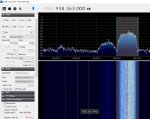Hi,
Saw this new TETRA decoding plugin for sdr# "https://www.rtl-sdr.com/tetra-decoder-plugin-for-sdr-now-available/".
The plugin seems to work just fine and bursts are received in the MSYS2 window.
However,for some reason the newtork is not recognized properly and I can't hear anything, although I see broadcasts and traffic on the channels via the MSYS2 window.
I know that encryption is not the problem because the "Network Info" window is completely empty (parameters "Air encryption 1" or "Air encryption 2" should appear in the Network Info window, among other network data).
I see that the first CRC COMP says "ok" but the second says "wrong" in the MSYS2 window so that might be the reason, not sure.
Tried set "minOutputSampleRate" value in "SDRSharp.exe.Config" file to 32000 and use WFM / set to 48000 with NFM. In both cases windows playback set to 48000.
Still the same.
Once in a while I hear a very short sound (last less than a second), might indicating tunning error? not sure.
Posted pictures below.
Any ideas?
Saw this new TETRA decoding plugin for sdr# "https://www.rtl-sdr.com/tetra-decoder-plugin-for-sdr-now-available/".
The plugin seems to work just fine and bursts are received in the MSYS2 window.
However,for some reason the newtork is not recognized properly and I can't hear anything, although I see broadcasts and traffic on the channels via the MSYS2 window.
I know that encryption is not the problem because the "Network Info" window is completely empty (parameters "Air encryption 1" or "Air encryption 2" should appear in the Network Info window, among other network data).
I see that the first CRC COMP says "ok" but the second says "wrong" in the MSYS2 window so that might be the reason, not sure.
Tried set "minOutputSampleRate" value in "SDRSharp.exe.Config" file to 32000 and use WFM / set to 48000 with NFM. In both cases windows playback set to 48000.
Still the same.
Once in a while I hear a very short sound (last less than a second), might indicating tunning error? not sure.
Posted pictures below.
Any ideas?
Attachments
Last edited:







